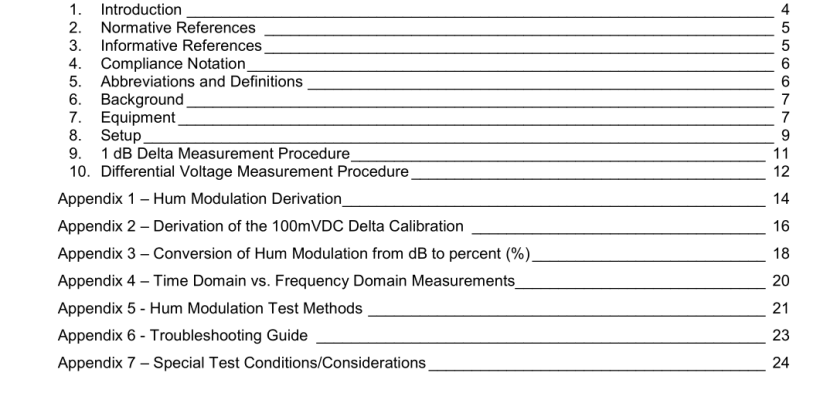ANSI SCTE 16-2018 pdf download.Test Procedure for Hum Modulation
1.2. Scope
The purpose of this test procedure is to define and measure hum modulation in active and passive broadband RF telecommunications equipment and sub-assemblies. This procedure presents two methods for measuring hum modulation in the time domain, with a sensitivity exceeding -80 dB. These methods are referred to as the 1 dB delta and the differential voltage method. A mathematical relationship between time domain and frequency domain measurement methods is also provided. This document provides specifications or procedures for frequencies up to 1002 MHz. DOCSIS 3.1 specifications include operation at frequencies up to 1218 MHz, and optionally, to 1794 MHz. Specifications or procedures for those higher frequencies should be considered in a future revision of this document.
1.3. Benefits
In a coaxial telecommunications system, AC power and radio frequency (RF) signals can exist on the same conductor. As a result, amplitude modulation of the transmitted signals at the power line frequency (hum modulation) can occur in both active and passive equipment due to excessive ac voltage at the output of a local power pack (in the case of an active device) or from parametric modulation of magnetic components (used in circuitry to separate power and signal voltages) in active or passive devices. In North American NTSC analog television systems, the frame repetition rate is 59.94 Hz and the commercial power frequency is 60 Hz. Amplitude modulation of the transmitted signals at the power line frequency (hum modulation) can cause picture disruption in the form of horizontal bars or brightness variation. Excessive hum modulation could also disrupt AGC circuitry commonly used in RF amplifiers, causing excessive RF level variations in the HFC plant. The FCC (Title 47, Part 76.605) requires that hum modulation does not exceed 3% of the visual signal level.
This test procedure for hum modulation, when executed according the procedure, will yield confidence in the measured hum modulation performance of the active or passive broadband RF telecommunications equipment under test. Use of this test procedure provides a means for the user to verify acceptable performance of the unit under test.
1.4. Intended Audience
The intended audience for this test procedure includes manufacturers, corporate engineers, technical operations, and technicians.
1.5. Areas for Further Investigation or to be Added in Future Versions
None at the time of update.
2. Normative References
The following documents contain provisions, which, through reference in this text, constitute provisions of this document. At the time of Subcommittee approval, the editions indicated were valid. All documents are subject to revision; and while parties to any agreement based on this document are encouraged to investigate the possibility of applying the most recent editions of the documents listed below, they are reminded that newer editions of those documents might not be compatible with the referenced version.
6. Background
In a coaxial telecommunications system, where AC power and radio frequency (RF) signals exist on the same conductor, hum modulation of a television signal is measured as a comparison between the modulation envelope (created by line power distortions of the RF carriers), and the peak voltage of the sync tips of the video signal. In a laboratory test environment, the video signal is replaced with a sine wave RF carrier. Under these conditions, the only modulation existing on the carrier is the line power related distortion (created by the device under test) of that carrier. Hum modulation is determined as a function of the line frequency current passing through the device by comparing the peak to peak modulation envelope of the power line distortion to the peak voltage of the carrier by utilizing a diode detector. Due to the non-linear characteristics of any diode detector, it is inaccurate to simply compare the AC modulation voltage and the rectified DC carrier voltage directly due to the voltage drop across the diode. Instead, the modulation voltage is compared to a calibrated change in the rectified carrier. There are two time-domain methods for measuring hum modulation in a laboratory environment, which are detailed in this procedure. These methods are commonly referred to as the 1 dB delta method, and the differential voltage method. These methods are described in Appendix 5.ANSI SCTE 16-2018 pdf download
